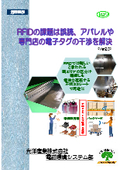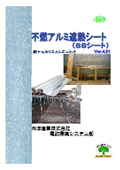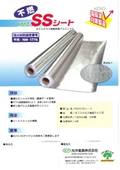Electronic tag radio wave interference, apparel, specialty store shielding measures.
We have improved the success rate of bulk reading of large quantities of products by preventing interference, misreads, and reading errors of RFID signals with a non-combustible SS sheet barrier, which also prevents the reading of non-target electronic tags.
● Before the measures were implemented, the electronic tags (RFID) on the apparel store side were being read by the reader on the back-end side, causing disruptions in operations. However, by spatially separating them with a non-combustible aluminum shield sheet partition (constructed on the back-end wall to prevent multipath interference, with ceiling installation examples depending on the environment), we reduced the impact of mutual interference and resolved the issue, and we are currently expanding renovations to all stores. ● By utilizing RFID and electronic shelf labels together, we can automate necessary parts, allowing us to allocate limited personnel to areas where human involvement enhances corporate value and the significance of the store, thus achieving true labor reduction. Recently, due to the pressure on radio waves leading to frequency shifts and reconfigurations, as well as an increase in RFID users and other wireless devices, cases of acquired radio interference and other obstacles have been observed. However, considering the characteristics of RFID, what is expected is not just labor reduction. ● The non-combustible certified aluminum electromagnetic wave shielding sheet used has obtained F☆☆☆☆ certification and fireproof certification (non-combustible: NM-1776). Its high shielding performance and durability make it user-friendly, and because it can be relatively easily installed in general interior construction, it is expanding its range of applications in various uses where specialized skills were previously required.
basic information
Features ● High performance in both shielding and heat insulation with aluminum foil sheets instead of aluminum vapor deposition. ● Reinforced with fiberglass, double-sided aluminum foil for durability, flexibility, and ease of handling. ● The joints are secured with a fold and reinforced with aluminum tape, resulting in minimal performance degradation over time. ● Installation methods, aging degradation, corrosion performance, etc., have all been verified through tests conducted at our EMC research facility. ● There are many proven results from combined use with other materials, and we possess measurement data.
Price range
Delivery Time
Model number/Brand name
RFID electronic tag shielding measures RFID electromagnetic wave shielding electronic tag electromagnetic wave shielding
Applications/Examples of results
Construction Achievements ● Measures against RFID tag reading errors in apparel, mass retailers, and general supermarkets ● Hospital facilities: EEG room, electromyography room, hearing test room ● Non-combustible heat-insulating sheets: residential buildings, public buildings, kindergartens, offices, factories ● Non-combustible shield SS sheets: numerous shielded facilities
Detailed information
-

【Backyard Non-combustible Aluminum Shield Sheet Installation】 By applying a non-combustible (required due to interior restrictions) aluminum shield sheet to the backyard side of the store partition, we prevent misreading of electronic tags displayed on the store wall shelves.
-

【Backroom Ceiling Surface Non-combustible Aluminum Shield Sheet Installation】 If there are openings for air conditioning ducts or recessed lighting fixtures near the store partition, and if interference cannot be improved by just the wall surface, a non-combustible aluminum shield sheet will be installed on the ceiling surface as well.
-

[Construction: Overlap 10 centimeters] We will overlap and paste to prevent radio wave leakage.
-

Construction: Stapling the overlapping parts. The overlapping areas will be secured with a stapler.
-

【Construction: Non-combustible aluminum tape for overlapping sections】 To prevent leakage from the overlapping sections, non-combustible aluminum tape is applied and pressed down with a roller to ensure adhesion.
-

Regarding Fireproof Certification: Fireproof Material Certification (Non-combustible: NM-1776) In construction under interior restrictions, non-combustible certification is required. 1) Fireproof materials are those materials defined or certified by the Minister of Land, Infrastructure, Transport and Tourism according to their performance classifications of non-combustible, quasi-non-combustible, and flame-retardant. ● When subjected to heat from a typical fire, building materials must meet the following key points: ◎ They must not ignite. ◎ They must not undergo harmful deformation, melting, cracking, or other damage that is detrimental to fire safety. ◎ They must not produce harmful smoke or gas that could impede evacuation. ● Each performance is determined by the time after heating begins. ◎ Non-combustible performance: 20 minutes after heating begins ◎ Quasi-non-combustible performance: 10 minutes after heating begins ◎ Flame-retardant performance: 5 minutes after heating begins 2) Fireproof performance is certified based on the combination of the substrate material (as per the Ministry of Construction Notification No. 1400, non-combustible materials are defined by the amendments to Ministry of Construction Notification No. 1400 and Ministry of Land, Infrastructure, Transport and Tourism Notification No. 1178, as determined by the Minister of Land, Infrastructure, Transport and Tourism) and the construction method.
-

【Construction: Partition with Retail Store】 SS sheets are being installed on the back wall and ceiling of the back yard. The scope is being confirmed on-site using a handheld scanner during the installation.
-

【Plate Replacement】 If there are outlets, switches, etc. installed on the partition wall, there are concerns about interference due to leakage, so please replace the areas using resin decorative plates with new metal (corrosion-resistant aluminum alloy) plates.
-

[One Proposal for Cases with Upper Openings] In cases where there is an opening at the top due to smoke compartmentation and other factors, it may be a viable option to adjust by installing a shield curtain. However, please conduct a legal check and address this at the user's own responsibility. Please be careful to ensure that it does not become illegal.
catalog(8)
Download All Catalogs





News about this product(2)
-

Countermeasures against RFID mutual interference: The 'non-combustible (mandatory under interior restrictions) aluminum SS sheet' that shields radio waves resolves issues of radio wave interference and misreading of tags in apparel, specialty stores, and supply chains, making it possible to conduct inventory segregation in the same area, which has been considered difficult with RFID until now.
【Over 1000 successful measures】●Before the measures, the electronic tags (RFID) on the apparel store side were being read by the reader on the back-end side, causing disruptions to operations. To resolve this, we spatially separated the areas with a non-combustible SS sheet partition (constructed on the back-end wall to prevent multi-path interference, with ceiling construction depending on the environment), thereby reducing the impact of mutual interference. The non-combustible aluminum electromagnetic wave shielding sheet we used has obtained 'F☆☆☆☆ certification and fire prevention certification (non-combustible: NM-1776)'. With the reinforcement material made of sturdy glass cloth, it exhibits strength that has not been seen before, making it less prone to holes or cracks due to bending during installation, unlike conventional products. The joints and holes are reinforced with SS tape of the same material, enhancing workability and providing excellent shielding performance. It has been used after passing installation performance tests at our EMC experimental building. We receive inquiries and consultations such as "I want to use it in this kind of place?" and "I'm having trouble utilizing it effectively," and we implement and measure the improvements discussed and proposed, reflecting them in our products. 'Smiring Company,' which continuously evolves to meet the diverse needs of this era, is Koyo Sangyo Co., Ltd.
-

[Over 1000 measures implemented] A method to solve radio interference and reading errors of electronic tags (resolved through store renovations in apparel, specialty stores, supply chains, etc.) is explained with photos. The construction points of non-combustible aluminum SS sheets (essential under interior restrictions) are clearly visible at a glance.
●One day, if the electronic tag (RFID) is affected by interference, I think it would be good to use this guide to take countermeasures. ●Improvements implemented based on issues are published with photos. ●The construction procedure for the wall includes explanations with photos on the overlap of aluminum sheets, the pitch for tacker fixation, and the method of fixing with aluminum tape. ●Measures for leakage from outlets and embedded lighting fixtures that occurred during actual construction are also noted. Due to the recent pressure on radio waves leading to frequency shifts and reorganization, as well as the increase in RFID users and other wireless devices, it is not uncommon for issues such as radio wave interference to occur as a result of these influences. UHF band IC tags have a long communication distance of about 3 to 5 meters, which can lead to interference when multiple IC tag readers are installed in close proximity. In particular, in Japan, the bandwidth allocated to UHF band IC tags is narrow at 2 MHz (for high-output types, while low-output types like handheld devices have 3 MHz), making it difficult to avoid interference. Wireless sensor networks utilize the high radio reach of the 920 MHz band and, through high reliability via multi-hop communication, are accelerating wireless IoT solutions.
Recommended products
Distributors
Our mission is to add our unique ideas and know-how to the new materials that are continuously emerging, in order to meet the needs of various industries, and to propose them as new products with added functionalities. Our functional composite materials exhibit excellent and original features across various fields, including home appliances, precision equipment, medical devices, construction, and transportation, as well as in areas such as equipment parts, special rooms, and architectural panels, thereby serving everyone effectively. "Reflecting the times and exploring the next generation" is our pride in our continuous development capabilities that lead the industry. We offer a variety of electromagnetic wave countermeasure products. Furthermore, to carry out these measures effectively and efficiently, we have established a system that allows us to conduct electromagnetic wave environment measurements, field surveys, construction advice, and shielding work consistently. Technology is not born overnight. Our employees cherish a proactive attitude towards "technologies that no one is doing," "technologies that are deemed impossible," and "unique technologies." In development, not everything is successful; in fact, failures are more common. However, it is also true that the byproduct technologies born from challenges support our company today.













































